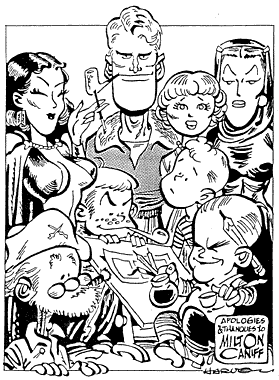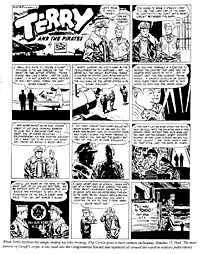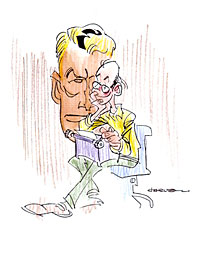New
Book on a Legend
 In
Milton Caniff Conversations, one of the
giants in the history of American comic strips talks about his life and
his craft in more than a dozen interviews that were conducted from 1937
to 1986, a period that embraces almost the entire span of his career producing
the nearly legendary Terry and the Pirates (1934-1946) and his post-World
War II masterpiece, Steve Canyon (1947-1988). For some telling tales
about the master, click here. Or keep reading
and scrolling.
In
Milton Caniff Conversations, one of the
giants in the history of American comic strips talks about his life and
his craft in more than a dozen interviews that were conducted from 1937
to 1986, a period that embraces almost the entire span of his career producing
the nearly legendary Terry and the Pirates (1934-1946) and his post-World
War II masterpiece, Steve Canyon (1947-1988). For some telling tales
about the master, click here. Or keep reading
and scrolling.Milton Caniff wasn’t
inept, exactly,
at drawing hands, but he wasn’t unreservedly enthusiastic about the results
of his efforts. And one hand he’d drawn even made him cringe a little.
It was Colonel Flip Corkin’s hand in the 9th
panel of the Sunday Terry and the Pirates for October 17, 1943.
Caniff felt he’d failed to get the thumb just
right. But the deadline closed in faster than he could fix it, so he sent
the page off to the Tribune-News Syndicate. He’d have ample opportunity
to make up for the lapse, he may have thought, in the hundreds of hands
he’d draw thereafter.
Ten weeks later, U.S. Congressman Carl
Hinshaw of California read this strip in his
Sunday newspaper and was immediately impressed with “the finest and most
noble sentiments” of trenchant patriotism in the speech Corkin
made to Terry, who had just been commissioned a pilot. “It is deserving
of immortality,” Hinshaw told his fellow legislators,
and he promptly read it into the Congressional Record. And that
was wonderful. But then the so-called “Pilot’s Creed”
page started getting reprinted as a poster that was circulated world-wide
throughout the World War II military establishment. Everywhere
he looked, Caniff saw that ugly hand. And he kept on seeing it for the
rest of his life: the Pilot’s Creed was reprinted in nearly every retrospective
of the cartoonist’s work.
 The Pilot’s Creed is reprinted again in a new book I edited for
the University Press of Mississippi, Milton Caniff Conversations (316 6x9-inch pages), the second
of its Conversations with Comic Artists Series (Charles Schulz was the
first). The book collects over a dozen previously published interviews
with Caniff from 1937 to 1986 and includes a modest sampling of
his art from Puffy the Pig, The Gay Thirties, Dickie
Dare, Terry and the Pirates, Male Call and WWII pin-ups and other
special drawings, and Steve Canyon (with preliminary sketches of
the character), some of it familiar and some of it seldom, if ever, reprinted.
Given the celebrity of the Pilot’s Creed, the book would be deficient
without it, so Flip Corkin’s deformed hand is
once again on display for all to see.
The Pilot’s Creed is reprinted again in a new book I edited for
the University Press of Mississippi, Milton Caniff Conversations (316 6x9-inch pages), the second
of its Conversations with Comic Artists Series (Charles Schulz was the
first). The book collects over a dozen previously published interviews
with Caniff from 1937 to 1986 and includes a modest sampling of
his art from Puffy the Pig, The Gay Thirties, Dickie
Dare, Terry and the Pirates, Male Call and WWII pin-ups and other
special drawings, and Steve Canyon (with preliminary sketches of
the character), some of it familiar and some of it seldom, if ever, reprinted.
Given the celebrity of the Pilot’s Creed, the book would be deficient
without it, so Flip Corkin’s deformed hand is
once again on display for all to see.
About Caniff’s
rendering of hands generally, I must agree with him. Some of his hands
don’t look very graceful. They’re unrelievedly
square, a chunk of bone and lumps of knuckle between elbow and fingertip,
no tapering at the wrist at all. When I was interviewing him for what
he called “the definitive biography,” I realized why the hands he drew
looked the way they did.
I started interviewing him in March
1984 at his East 45th Street studio in New York. He lived in the same
building, commuting every day from his apartment on the 30th floor to
5E on the fifth floor, a tiny one-bedroom apartment. In the bedroom, a
twin bed for napping was jammed in among numerous filing cabinets. The
livingroom was his studio. The walls were hung
with framed original drawings, his own sometimes but mostly those of Noel
Sickles and other artists. He propped his drawing board against a worktable
in the middle of the room, facing a couch against the opposite wall. At
his back were bookcases filled with ready reference. I sat at his left
with my tape recorder silently spooling away on the top of a two-drawer
filing cabinet next to the drawing board. As he talked, answering my questions,
he drew. He never just sat. He was always drawing. And that’s when I noticed
his hands. They were not the hands of an artist: they were large and square,
chunks of bone and sinew, no tapering at the wrist whatsoever. And like
most artists, when he drew hands, he used his own as models.
The East 45th Street studio was only
a block or so away from the Palm, the one-time speakeasy on Second Avenue
that had become a hangout for cartoonists in the 1930s and, with the repeal
of Prohibition, a restaurant. Its walls are defaced with “merry murals”
(as Caniff would say), drawings of their characters by the cartoonists
who frequented the place. And Caniff was one
of those. “It was our livingroom,” he told me,
speaking of his first years in New York when he lived in nearby Tudor
City.
He took me to dinner a couple of times
at the Palm. He’d phone in advance to see if a table was available, and
when we entered, we were met at the door by a phalanx of waiters. “Good
evening, Mister Caniff,” one would say. “Your
table is ready, Mister Caniff,” said another.
“Right this way, Mister Caniff,” gestured a
third.
One time, we sat in the second room
at a table for two next to the wall on which was a framed Steve Canyon
strip, the one from April 30 1947 in which Steve and Delta are depicting
having dinner at the Palm.
“Someone stole the original,” Caniff said about the strip. “This is a
photostat.”
A waiter walked by and said, “Good
evening, Mister Caniff” as he passed.
“Good evening, George,” Caniff said. “He’s been here forever,” he continued to me;
“—he was just a kid, a busboy, when we first came here.”
Caniff also
took me once to Costello’s, around the corner and down the block from
the Palm. We had lunch.
“This is a writer’s place,” Caniff explained. “James Thurber came here. And Walt Kelly. Not here exactly: the place used to be a couple
blocks from here when Thurber was around. He drew on the walls, and when
they moved the place, they cut out the sections of the walls with his
pictures on them and brought them here.”
Some cartoonists, including Caniff, had been invited to decorate the backroom in the fashion
of the Palm, but it was sparkling new artwork on a freshly white-washed
wall not the haunting vintage imagery on the Palm’s faded plaster.
On another occasion, Caniff took me to the Society of Illustrators Clubhouse on
63rd Street. “You have to visit these places,” he explained, “—for the
biography. These places are part of the story.” The National Cartoonists
Society, lacking a clubhouse of its own, often met, in the early days,
at the Illustrators’.
I spent several days interviewing Caniff in 1984 and returned once in a later year for more.
And we spoke on the telephone at other intervals: I would discover questions
as I wrote, and periodically, I’d send him a list and then phone for the
answers.
My 1984 visit straddled a weekend,
and late on Saturday afternoon, Caniff called
it a day, saying that he had to get dressed for dinner. He and Bunny,
his wife, were going out that evening to attend the Air Force Salute,
the annual ball of the New York’s Irongate Squadron
of the Air Force Association. Caniff was one
of the founders of the group and had served as commander in 1965, when
the Irongate Squadron set the national pace
for fund-raising dinners for Air Force charities.
“It’s black-tie,” Caniff said, “so I’ll have to wear the monkey suit.”
I returned the next morning at about
10 o’clock to continue our session. Caniff met
me at the building entrance on the ground floor. Usually he awaited my
arrival upstairs in the studio, but, he explained, he’d just happened
to come down for the Sunday paper. He was still wearing his tuxedo. He’d
gone directly from the banquet to his studio to finish some strips. Presumably,
he’d worked through the night, perhaps stopping to nap a little, as he
often did.
When we got to the studio, he removed
the tux jacket and sat down at the drawing board. He started to draw,
and I cranked up the tape recorder again. After an hour or so, I noticed
that he was squirming in his chair, something he’d not done before. Finally,
after several fidgety minutes, he exclaimed:
“It’s this cummerbund! I forgot to
take it off.”
He’d worked all night with it on.
Caniff’s
dedication to work was legendary. I interviewed several of his friends
and associates—James Reston, Dick Rockwell, and others, including Bill
Mauldin. For several years after World War II, Mauldin had lived near
the Caniffs in Rockland County, and I wanted him to tell me about
life along the fabled South Mountain Road where Maxwell Anderson, Lotte Lenya, Kurt Weill, and John Houseman—and the Caniffs—lived.
The poker parties at the Caniffs were a regular
social event, and I wrote Mauldin, asking if he’d agree to let me interview
him about this period of Caniff’s life.
Mauldin didn’t respond, so after waiting
several weeks, I phoned him in New Mexico.
Oh, yes, he said, he remembered my
letter, but he hadn’t responded because, he said, he couldn’t tell me
anything about Caniff in those days. There just
wasn’t anything to talk about, he said. Well, yes, he’d spent a lot of
the wee hours of the day in Caniff’s studio,
watching Caniff draw and talking. They’d talked about how to draw jeeps
and airplanes.
“The windshield on a jeep,” Mauldin
said, “goes straight up, perpendicular to the hood. Milt was drawing it
on a slant. I corrected him on that.”
As for the poker parties,
Caniff wasn’t there much, Mauldin explained.
He was present when the evening started and usually played a couple of
hands. Then he excused himself, pleading the imminence of deadlines, and
went up to his studio, where he worked until the party was ready to break
up. Then he’d come down and have a nightcap with everyone, Mauldin said.
“He was always working,” Mauldin continued.
“Even at those parties the Cartoonists Society had in the summer at Fred
Waring’s place in Pennsylvania. Everyone would
be in the bar or around the pool, and Milt would be in his room, drawing.”
And all this came from the man who
said he couldn’t tell me anything about Caniff.
None of these stories are in Caniff Conversations. But there are long interviews
conducted by such cartooning luminaries as Jules Feiffer
and Will Eisner (The Spirit and Contract with God) in which
Caniff discusses how he developed the famed chiaroscuro drawing
style as well as his passion for realism in every detail, both visual
and narrative, and his relationships with other cartooning greats like
Al Capp (Li’l Abner)
and Noel Sickles (Scorchy Smith) and
Alex Raymond (Flash Gordon). Few of the interviews and commentaries
in this volume are likely to have been seen or read by many because most
of the material has been gleaned from difficult-to-find publications not
in general circulation. Caniff’s status as a
spokesman for the military in general and the Air Force particularly,
for instance, is attested to by interviews with reporters from military
magazines and newspapers.
Two of the interviews from later years
were conducted by Shel Dorf,
who lettered Steve Canyon for twelve years and who was intimately
familiar with Caniff’s work. And a particularly
wide-ranging interview with Arn Saba in The
Comics Journal, long unavailable except in fugitive back issues of
the magazine, is here reprinted in full. We learn in these interviews
about how Caniff contributed to the morale of servicemen during World
War II, both with Terry and with Male Call, a special somewhat
risque weekly strip he drew for base newspapers, and about
how Caniff’s loyalty to military personnel cost
his strip vital circulation during the Vietnam War. We read Caniff’s
own eulogy for Terry, written when the strip ceased in 1973, and
his drawing assistant’s fond farewell, published shortly after Caniff’s
death in 1988. Although chiefly a text production, the book includes a
few rare samples of Caniff’s graphic artistry—preliminary
sketches for Steve Canyon, pin-up art from World War II military publications,
special drawings produced for Caniff’s fraternity
magazine, and a sample of vintage strips from all Caniff’s
oeuvre. And there’s a chronology of Caniff’s
life, laying out, year by year, all the major events and works of his
remarkable career.
The paperback with the colorful cover
depicted on our main page
is $24, which includes First Class postage; an unjacketed hardcover is
also available for $52, again including First Class postage. To order
your copy, inscribed by the editor (me), click here.
Art of the Comic Book - Accidental Ambassador Gordo - reviews - order form - return to main page - Rants & Raves - Harv's Hindsights
